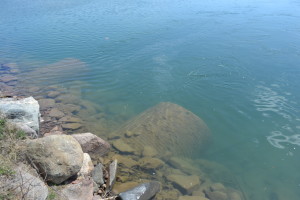We have much more to do and your continued support is needed now more than ever.
Reclaiming Rapids for the Great Lakes
There is no one quick, easy answer for wildlife conservation. A huge part of the challenge is balancing actions that are good for humans with those that are good for wildlife. Often, these are the same (clean water, clean air, open spaces, etc.), but sometimes there are tradeoffs, and we as conservationists work hard to protect wildlife habitat while promoting thriving human systems.
A prime example of this is the Soo Locks, in Sault Ste. Marie, Michigan (prounounced Soo-Saint-Marie). The locks were created to allow freighters to travel through the shallow and turbulent St. Marys River, into Lake Superior, and on to cities like Marquette, Mich., and Duluth, Minn. Allowing shipping to reach these ports—bringing loads of coal into and transporting mining materials outside the Great Lakes was an important economic advancement for the Great Lakes.
A Legacy of Problems

One of the few places that can still be restored close to its original state is the Little Rapids—located about two miles downstream from the Soo Locks and adjacent to Sugar Island. The Little Rapids were once prime fish-spawning habitat with fast flowing shallow water over exposed pebbles. Now, due to an inter-island causeway that blocks all but a fraction of the river from flowing between two islands, the Little Rapids are slow and stagnant, allowing sediments to settle onto the rocky bottom.

This is where it gets tricky—the causeway isn’t the only option for getting cars around the island; there are other options that would allow the historic rapids to return and create more spawning habitat for fish. A team led by the Eastern Upper Peninsula Regional Planning and Development Commission is exploring this option. In 2011, they received a grant from the National Oceanographic and Atmospheric Administration to do the engineering and design to restore the Little Rapids. The grant will allow them, along with their project partners, to take a thorough look at what removing all or part of the causeway would mean for people and wildlife around the islands, and what options are plausible for allowing transportation among the islands. The project will undergo all of the pre-construction tasks for restoring the rapids:
- Hydraulic Flow Modeling to assess what effects the project will have on navigation and ice formation in the St. Marys River
- Engineering Design to modify the Sugar Island Causeway to restore flow to the Little Rapids and allow for fish passage.
- An Environmental Assessment to examine the effects the project will have on the surrounding environment.
- Environmental Monitoring to look at physical and biological aspects of the project before, during, and after implementation. Monitoring will make sure that environmentally sensitive species and habitats are not harmed by any step of the project and allow us to learn from the project.
- Outreach and Education efforts to involve the many stakeholder interests of the Little Rapids project by making sure groups like sportsmen, residents, recreational boaters, and other entities are informed engaged as the project progresses.
Climate Considerations

- Water Levels: Climate projections show that Great Lakes water levels may go either up or down, and that they will likely be more variable than they have in the past. Water levels in the St. Marys River are heavily controlled by the locks and compensating gates, but do change to follow Lake Huron’s levels.
- Ice Cover: With warmer air and water temperatures, Great Lakes ice cover may be decreasing in coming years. Many residents of Sugar Island are worried that removing the causeway may divert enough water flow from the current channel to slow the current, allowing more ice to form and preventing the ferry—their only access to the mainland for buses and emergency vehicles—from crossing the channel. Less ice cover due to climate change may, in fact, eliminate one challenge in removing the causeway. However, many island residents enjoy walking on the ice near the rapids site to visit their neighbors.
- Water Temperatures: Since one of the main goals of this project is to establish rapids for fish spawning and habitat, we will have to consider if anticipated changes in water temperatures will have an effect on the types of fish who will be using the rapids.
Next Steps





















